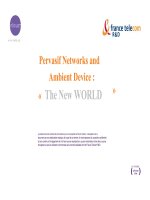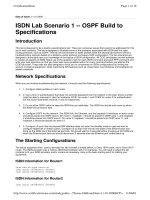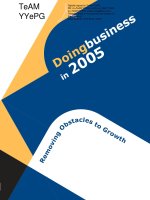Tài liệu Are Corruption and Taxation Really Harmful to Growth? docx
Bạn đang xem bản rút gọn của tài liệu. Xem và tải ngay bản đầy đủ của tài liệu tại đây (70.32 KB, 25 trang )
Are Corruption and Taxation Really Harmful to Growth?
Firm Level Evidence
April, 2002
Raymond Fisman
*
and Jakob Svensson
#
Abstract
Exploiting a unique data set containing information on the estimated bribe payments of
Ugandan firms, we study the relationship between bribery payments, taxes and firm
growth over the period 1995-97. Using industry-location averages to circumvent the
potential problem of endogeneity, and to deal with issues of measurement error, we find
that both the rate of taxation and bribery are negatively correlated with firm growth. For
the full data set, a one-percentage point increase in the bribery rate is associated with a
reduction in firm growth of three percentage points, an effect that is about three times
greater than that of taxation. Moreover, after outliers are excluded, we find a much
greater negative impact of bribery on growth, while the effect of taxation is considerably
reduced. This provides some validation for firm-level theories of corruption which posit
that corruption retards the development process to an even greater extent than taxation.
*
Columbia Business School. 614 Uris Hall, Columbia University, New York, NY, 10027. Email:
Telephone: (212) 854-9157. Fax: (212) 316-9355
#
Institute for International Economic Studies, Stockholm University, 106 91 Stockholm, Sweden. Email:
Telephone: (+46) 8 163060. Fax: (+46) 8 161443.
We are grateful for comments by Aart Kraay, Torsten Persson, Ritva Reinikka, and David Strömberg.
2
I. Introduction
The debate on the effect of corruption on economic growth has been a hotly contested
issue for several decades. Often, the effect of corruption is thought of as being something
like a tax, differing primarily in that the payment does not end up as public revenues.
1
To
the extent that this deprives the government of revenue required to provide productive
public goods, corruption may be more detrimental to growth than taxation. More
recently, Sheifer and Vishny (1993) have argued that corruption may be far more
damaging than taxation, because of the uncertainty and secrecy that necessarily
accompany bribery payments. On the other side, proponents of ’efficient corruption’
claim that bribery may allow firms to get things done in an economy plagued by
bureaucratic holdups.
2
Moreover, it has also been argued that a system built on bribery
will lead to an efficient process for allocating licenses and government contracts, since
the most efficient firms will be able to afford to pay the highest bribes (see Lui, 1985).
Hence, the issue of whether bribery is more harmful than taxation, or if, in fact,
corruption is damaging at all, is primarily an empirical question. The relationship
between growth and corruption has been examined extensively in the macro literature,
beginning with Mauro (1995). In general, these studies find a negative correlation
between corruption and GDP growth. On the issue of taxation versus bribery, Wei
(1997) finds that bribery has a much stronger negative impact on foreign direct
1
See Johnson, Kaufmann, & Shleifer (1998) on the public finance aspect of corruption, and Bardhan
(1997), Tanzi (1998), and Wei (1999) for reviews of existing literature.
2
See the discussion in Bardhan (1997). Kaufmann and Wei (1998) provide some indirect evidence in line
with Myrdal’s (1968) argument that corrupt officials may instead of speeding up, actually cause
administrative delays in order to attract more bribes. See also Banerjee (1997) and Svensson (2002).
3
investment than taxation. This body of work is based entirely on cross-country analyses,
however, which always raises serious concerns about unobserved heterogeneity across
data points. Moreover, the data on corruption is based on perception indices, typically
constructed from experts’ assessments of overall corruption in a country, raising an
additional concern about perception biases. Finally, the cross-country work on the
relationship between corruption and growth tells us little about the effect of corruption on
individual firms: for example, the negative relationship between growth and corruption at
the country level may derive from an inefficient provision of public goods. If this were
the case, corruption would not be damaging for the reasons cited by Shleifer and Vishny,
and others that focus on firm-level theories of corruption.
In this paper, we take advantage of a unique data set that contains information on
the estimated bribe payments of Ugandan firms. We find that there is a (weak) negative
relationship between bribery payments and firm growth over the period 1995-97. After
noting the potential problems of endogeneity and measurement error, we look at the
relationship between firm growth and bribe payments, using industry-location averages
as instruments, and find that the negative effect is considerably stronger. For the full data
set, a one percentage point increase in the bribery rate (as defined by bribe payments
divided by sales) is associated with a reduction in firm growth of more than three
percentage points, an effect that is about 2.5 times greater than that of taxation.
Moreover, after outliers are excluded, we find a much greater negative impact of bribery
on growth, while the effect of taxation is considerably attenuated. This provides some
validation for firm-level theories of corruption which posit that corruption retards the
development process to a greater extent than taxation.
4
The rest of this paper is structured as follows: in Section II, we will describe the
specification that we intend to use to examine the relationship between growth and
corruption. Section III describes the data, including details of how our data on bribe
payments were collected. The results are given in Section IV. Finally, Section V
concludes.
II. Empirical Strategy
There are two main econometric issues of assessing whether corruption will have
a significant retarding effect on growth: (i) problems due to measurement errors, and (ii)
the fact that both growth and corruption are likely to be jointly determined. Below we
discuss how we attempt to deal with these issues.
If bureaucrats can customize the nature and amount of harassment on firms to
extract bribes, the “required bribe” will depend on the firm’s willingness/ability to pay
(see Bliss and Di Tella, 1997, and Svensson, 2003). Two firms in the same sector may
thus need to pay different amounts in bribes, and the difference may be correlated with
(unobservable) features influencing the growth trajectory of the firms. A simple example
illustrates the point. Consider two firms in a given sector of similar size and age, which
are located in the same region. One of the firms is producing a good/brand that is
perceived to have a very favorable demand forecast, while the other firm is producing a
good with much less favorable demand growth. Assume furthermore that the firms need
to clear a certain number of business regulations and licensing requirements, and/or
5
require some public infrastructure services; moreover, assume that the bureaucrats have
discretion in implementing and enforcing these regulations and services. A rational and
profit maximizing bureaucrat would try to extract as high a bribe as possible, subject to
the constraints that the firm might exit, and/or the bureaucrat may get caught. In this
setup we would expect a bureaucrat to demand higher bribes from the firm producing the
good with a favorable demand forecast, simply because this firm’s expected profit are
higher and, thus, its ability to pay larger. If the forecasts also influence the firms’
willingness to invest and expand, we would expect (comparing these two firms) a
positive (observed) relationship between corruption and growth.
A second problem of endogeneity arises if firms may specialize in rent-seeking or
efficiency as a means of growth. Specifically, it is possible that firms may differentially
choose to devote resources to obtaining valuable licenses, preferential market access, and
so forth. Thus, some firms choose to compete based on costly preferential bureaucratic
access, while others focus on improving productivity and investing in new capital (see for
example Murphy et al., 1991). Both strategies may lead to growth, and in equilibrium, it
is not clear that either firm type will grow more rapidly. This effect will tend to attenuate
any measured effect between bribery and growth.
The preceding difficulties will tend to mask any direct negative effect that
corruption has on growth. These problems may be mitigated by instrumenting for bribes.
Our identification strategy can be laid out formally with minimal notational complexity
by initially disregarding the relationship between growth and taxation. We can then state
the relationship between firm growth (
γ
ij
) and corruption (b
ij
) as:
), ),((
ijijijijij
pb
θθγ
Γ=
(1)
6
where subscripts refers to firm i in sector j. In (1),
θ
ij
is a firm-specific (unobservable)
factor that may impact both bribery rates and firm growth, p
ij
is a variable capturing the
firm’s growth potential. The firm’s growth potential can be decomposed into two parts,
where X
ij
is a vector of observable characteristics, and
η
is a zero-mean error term.
Linearising the model yields,
Our previous discussion implies that the omitted variable
ij
is correlated with both
JURZWK DQGEULEHU\FRUUE ,QOLQHZLWKWKHGLVFXVVLRQLQWKHLQWURGXFWLRQ
ZHDVVXPHWKDW >0 and FRUUE !)RUH[DPSOHZHFDQWKLQNRIWKHVKLIWVLQGHPDQG
described above that is likely to influence both the “required” bribe and growth.
3
$VVXPLQJIRUVLPSOLFLW\WKDW LVHVVHQWLDOO\XQFRUUHODWHGZLWKX, this leads to the usual
omitted variable bias; given our assumptions, the bias will be towards zero, resulting in
an underestimate of the effects of bribery.
Following the discussion above, our identifying assumption to deal with this
problem is that b
ij
can be decomposed into two terms, one industry-specific, and the other
particular to the firm:
3
The model could equivalently be framed in terms of simultaneously determined bribery rates and growth,
leading to a simultaneity bias from OLS.
ijij
Xp
ηδ
ij
+
′
=
,
b0 ijijijiji
Xb ++
′
++=
θβββγ
θ
(2)
(3)
(4)
jijij
BBb +=
7
In (4), B
j
denotes the (average) amount of bribes common to industry-location j, which in
turn is a function of the underlying characteristics inherent to that particular industry-
location, determining to what extent bureaucrats can extract bribes, while B
ij
denotes the
idiosyncratic component. More importantly, since we assume that the industry-specific
part of bribery is determined by underlying technologies and the rent-extraction talents
and inclinations of bureaucrats, we assume that this component is exogenous to the firm,
DQGKHQFHXQFRUUHODWHGZLWK )RUH[DPSOHVXFKLQGXVWU\VSHFLILFIDFWRUVPLJKWLQFOXGH
the extent to which the market for the produced goods is abroad, import reliance, and
dependence of publicly provided infrastructure services. Likewise, we expect rent
extraction through bribery to differ across locations simply because some bureaucrats
may be more effective at extracting bribes than others. If this assumption is valid, we
may use B
j
to instrument for b
ij
, since corr(B
j
, )=0. In such a specification, using
industry-location averages as an instrument for firm-level bribery gets rid of the bias
resulting from unobservables that are correlated with bribery at the firm, but not industry-
location, level.
The other significant estimation issue that we wish to address is the extent and
impact of “noisy” data, which is a common concern when using micro-level data. Despite
our data collection strategy outlined below, measurement errors, particularly in the bribe
data, are likely to be of concern, simply because of the secretive nature of these data.
Using grouped averages as instruments to deal with measurement error is a common
technique.
4
In our case, the industry-location averages we use should serve to mitigate
the effects of measurement error, since we generally think of these errors as being largely
8
idiosyncratic to the firm, and hence uncorrelated with the average bribery values.
In a country such as Uganda, where tax authorities have a high degree of
discretion (see Chen and Reinikka, 1999), we might expect that the relationship between
effective tax rates (
τ
) a firm needs to pay and growth to be influenced by the same types
of mechanisms. A rational tax collector (who may also be corrupt) can levy higher taxes
on a firm with higher current or expected future profits, and the firm (given expectations
of high future profits) may also be more willing to comply. Similarly, a firm may
specialize in evading taxes and colluding with the tax collector, or improving
productivity.
Before proceeding, we wish to discuss the plausibility of our identifying
assumption. The key assumption we make is that corr(B
j
, )=0; the primary objection to
this is that there might be processes at the industry-location level that are correlated with
, and required bribe payments. There are several reasons to believe that this is not the
case. First, our data set consists of primarily small and medium firms across a spectrum
of the most important industrial categories and regions in Uganda. While there is ample
anecdotal evidence of firms that have gained (and gained substantially) by bribing
officials (and politicians), and firms that for different reasons have been harassed, these
episodes appear to be idiosyncratic with respect to industry-locations. We know of no
evidence (systematic or anecdotal) that suggests that any of the industries-locations in the
data set have been systematically favored (or disfavored) by the government. In most
cases, these anecdotes refer to a small set of large enterprises with good connection to the
4
See Wald (1940) for the original contribution.
9
political elite. In addition, even if there are processes at the industry-location level, it is
not obvious how they would influence the results. Admittedly, if government officials
systematically increase both the regulatory burden and demands for bribes for some
industry-locations, then our instrument procedure would over-estimate the negative effect
of bribe payment. However, if government officials systematically choose to victimize
(i.e., demand higher bribes from) industries/locations with high growth potential, this
would attenuate any relationship between growth and industry-location bribery averages,
and thus work against our finding any effect. In section 4, we provide empirical evidence
supporting these claims, our instruments (industry-location averages) do not appear to
pick up other unobserved industry-location effects that are correlated with growth.
Our empirical model is,
where b
INS
and
τ
INS
are the fitted values from the first stage regressions, using location-
industry averages of b and
τ
as instruments, and including the same vector of controls X
as covariates.
III. Data
All data used in the paper is from the Ugandan Industrial Enterprise Survey (see
Reinikka and Svensson, 2001, for details). This survey was initiated by the World Bank
primarily to collect data on the constraints facing private enterprises in Uganda, and was
,
b0 ii
INS
i
INS
ii
Xb
ητβββγ
τ
+
′
+++=
(5)
10
implemented during the period January-June 1998. A total of 243 firms were interviewed
in 5 locations, in 14 different industries.
Of primary concern is the issue of whether reliable data on corruption may be
collected. For a long time it has been the common view that, given the secretive nature
of corrupt activities, it would be virtually impossible to collect reliable quantitative
information on corruption. However, with appropriate survey methods and interview
techniques firm managers are willing to discuss corruption with remarkable candor.
The empirical strategy utilized to collect information on bribe payments across
firms in Uganda had the following six key components (see Svensson, 2003, for details).
First, an employers’ association (Ugandan Manufacturers' Association) carried out the
survey. In Uganda, as in many other countries, people have a deep-rooted distrust of the
public sector. To avoid suspicion of the overall objective of the data collection effort, the
survey was done by a body in which firms had confidence. The co-operation with the
main private sector organizations had the additional advantage of most entrepreneurs
feeling obliged to participate in the survey. Second, questions on corruption were phrased
indirectly to avoid implicating the respondent of wrongdoing. For example, the key
question on bribe payments was reported under the following question: “Many business
people have told us that firms are often required to make informal payments to public
officials to deal with customs, taxes, licenses, regulations, services, etc. Can you estimate
what a firm in your line of business and of similar size and characteristics typically pays
each year?”. Third, corruption-related questions were asked at the end of the interview,
when the enumerator(s) had presumably established credibility and trust. Fourth, multiple
questions on corruption were asked in different sections of the questionnaire. The survey









